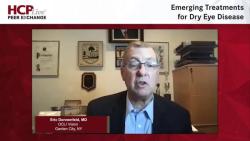Advances in the Management and Treatment of Dry Eye Disease - Episode 5
Dry Eye Disease Diagnosis
Experts provide an overview of the diagnostic process for identifying dry eye disease.
Kendall Donaldson, MD, MS: Laura, could you share your best and easiest way to make the diagnosis up front? [Share] your favorite tools, or how you make the diagnosis of dry eye in your clinic.
Laura Periman, MD: I’m a little stumped on my easiest and best because I don’t have 1 simple way to do it.
Kendall Donaldson, MD, MS: Or a cluster of things.
Laura Periman, MD: It’s a 4-step approach. One is asking the questions on standardized questionnaires. Those are QR [quick response] coded, which saves time for the clinician. They can be scanned on your smartphone as soon as you check in. You’ve got a SPEED [Standard Patient Evaluation of Eye Dryness] score reading, an OSDI [Ocular Surface Disease Index], or a DEQ-5 [5-item Dry Eye Questionnaire]. Whatever it is, you have data and can track it over time. The second step is to assess the risk factors. Is this patient older? Are they on glaucoma medications? Is this somebody who’s in front of the computer all the time? Are they’re younger? Are they a contact lens wearer? Assess the risk factors. Do your diagnostics, which includes osmolarity, MMP9, or inflammatory load testing. [Those] give you some insight into all that cytokine inflammatory mischief that Brandon [Ayres] alluded to.
Finally, categorize and treat. In that process, I’m looking for all the coconspirators. Is there a smoldering allergic component that I need to deal with? Is there a lifestyle factor that I need to deal with? Patients with rosacea need to go hard-core gluten-free or dairy-free. It’s a new way of life. That would be a little hard in Wisconsin, Paul. But Grandma was right: you are what you eat. That 4-step process drives my diagnostic evaluation and therapeutic approaches.
TRANSCRIPT EDITED FOR CLARITY



